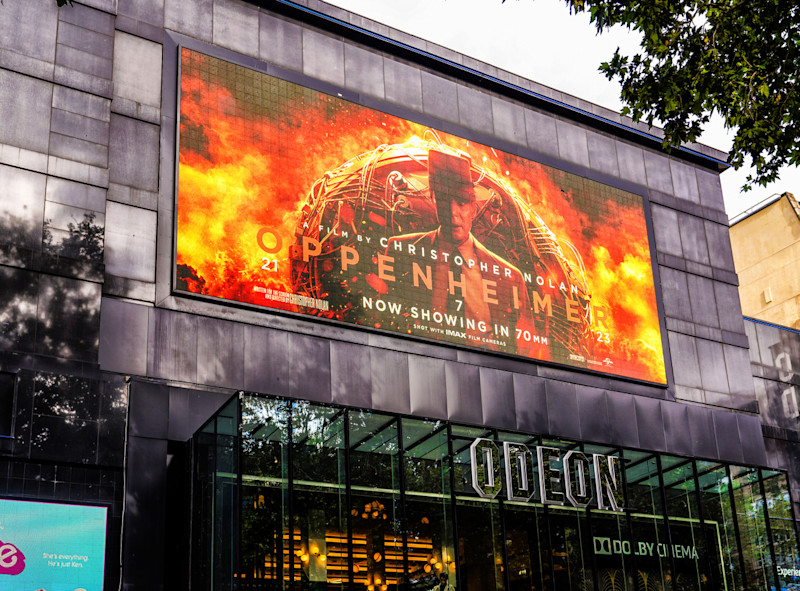Manufacturing does not often make it to the big screen. With the spotlight on best picture nominee, “Oppenheimer,” in the run up to the Golden Globes, we took a closer look at how defense manufacturing is portrayed in the film.
Manhattan Project in the Spotlight “Oppenheimer” (as you no doubt heard a few times last summer) tells the story of J. Robert Oppenheimer, a genius physicist, abysmal husband/boyfriend, and possible communist sympathizer who directed the Manhattan Project — which ultimately led to the development of the atomic bomb and helped bring WWII to an end. He was initially lauded as a hero and then later stripped of his security clearance based on dubious charges.
DIB is Big Business While this term would not have been used at the time, we see a major buildup of the defense industrial base (DIB) in “Oppenheimer.” DIB includes all the organizations that supply the U.S. government with materials, products, and services for defense purposes. “The U.S. defense manufacturing sector employs millions of workers across the country and contributes more than $200 billion to the economy each year,” cites the National Security Technology Accelerator.
The Manhattan Project team was tasked with building a technology for the government that didn’t previously exist. To accomplish this goal, they built a city in the middle of the desert complete with then state-of-the art testing and production facilities. They made a bomb factory. They were also racing against the clock to complete the project before the Nazis. So, there was a bit of pressure.
While all defense projects aren’t fodder for blockbuster movies, the U.S. government still relies on manufacturers to solve the complex, technical challenges of modern warfare and defense. Manufacturing is as essential to national security as ever, but the challenges have changed.
Today, DIB providers are not just developing defense systems, they are also creating software, handling cybersecurity, and developing new technologies to ready war fighters for battlefield challenges that were unimaginable in the 1940s.
A Security Evolution While Oppenheimer doesn’t spend a lot of time on security, they appear painfully lax to a modern viewer. There is a gate. That’s about it. The main security is the physical location. The dusty desert vistas make it clear that the team is alone out at Los Alamos.
By contrast, today’s physical security is much more advanced and involved. Unfortunately, modern threats also come from the internet around the clock. Cybersecurity is now big business and the key to business success. Everyone from massive manufacturers to small job shops has to worry about cybersecurity. The government also places stringent cyber and physical security requirements on contractors.
Safety – Near Zero Perhaps the most troubling scene in the film from the perspective of someone in modern manufacturing was watching the scientists watch the Trinity test blast while holding up small glasses over their faces, or putting on their goggles if they were among the lucky few who had them (why so few goggles?). The scene was resplendent with towering walls of fire and sound that envelopes you in the blast. The scientists see, hear, and feel the blast — all with little protection.
Oppenheimer’s most memorable line is uttered in this scene. When asked what the chances are of something going wrong, he replies, “Near zero.” Not zero.
Imagine that response today. Modern manufacturing facilities are full of safety protocols, fail safes, and testing requirements (and for good reason). While the scene was moving, it was shocking to see from a safety perspective.
A Mixed Victory Ultimately, once the bombs were completed, Oppenheimer had no control over their use. In one particularly poignant scene, he is giving a “victory” speech to the researchers and scientists who dedicated thousands of hours (and moved their families to the desert) to make this happen. But in a moment of personal torture, Oppenheimer is envisioning what happens to humans when they are exposed to radiation. He wanted peace but knew that winning the war was the only way to get there. Oppenheimer also realized how little control he ultimately had over the amazing technology he helped develop.
The tie to modern manufacturing in this scene is not the moral dilemma; it is how incredibly personal and poignant these types of major technological feats can be. The people at Los Alamos became a family, and the same is still true in labs, shops, factories, and facilities throughout the country. It is these types of manufacturing families that continue to make history.
As the DIB has evolved over the years, it has relied on our industry’s technological advancements. Both remain essential to our nation’s defense, as well as to the aerospace, medical, and general manufacturing industries. As a major driver of the economy and an integral piece of national security, DIB and manufacturing continue to have a direct impact on the prosperity of our country and the security of its citizens.
In September this year, you can experience all the advancements in manufacturing at IMTS 2024, Sept. 9-14, in Chicago, Ill. Register now.






